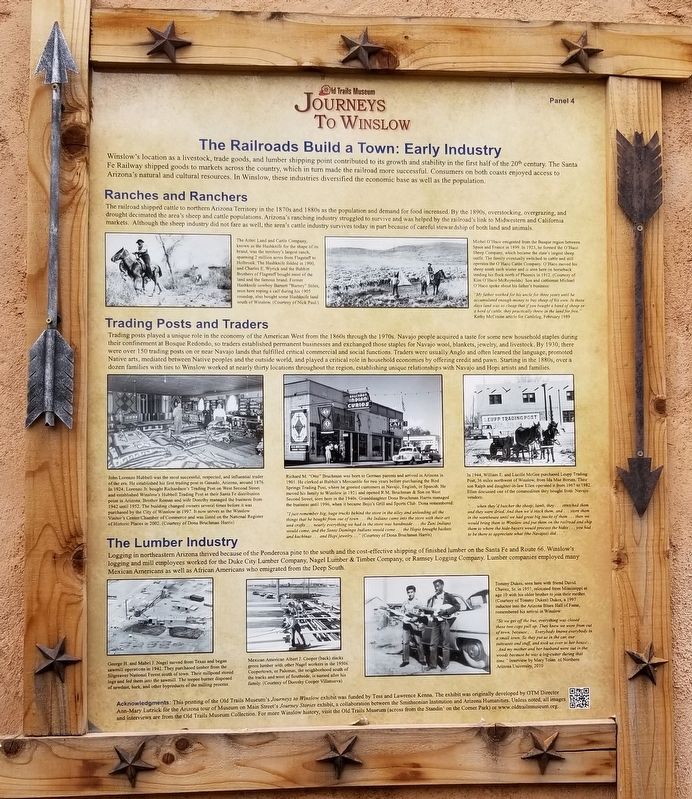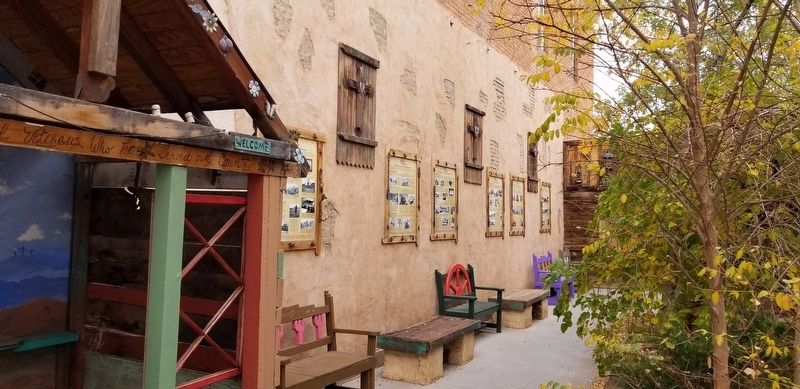Winslow in Navajo County, Arizona — The American Mountains (Southwest)
The Railroads Build a Town: Early Industry
Journeys to Winslow
Ranches and Ranchers
The railroad shipped cattle to northern Arizona Territory in the 1870s and 1880s as the population and demand for food increased. By the 1890s, overstocking, overgrazing, and drought decimated the area's sheep and cattle populations. Arizona's ranching industry struggled to survive and was helped by the railroad's link to Midwestern and California markets. Although the sheep industry did not fare as well, the area's cattle industry survives today in part because of careful stewardship of both land and animals.
Trading Posts and Traders
Trading posts played a unique role in the economy of the American West from the 1860s through the 1970s. Navajo people acquired a taste for some new household staples during their confinement at Bosque Redondo, traders established permanent businesses and exchanged those staples for Navajo wool, blankets, jewelry, and livestock. By 1930, there were over 150 trading posts on or near Navajo lands that fulfilled critical commercial and social functions. Traders were usually Anglo and often learned the language, promoted Native arts, mediated between Native peoples and the outside world, and played a critical role in household economies by offering credit and pawn. Starting in the 1880s, over a dozen families with ties to Winslow worked at nearly thirty locations throughout the region, establishing unique relationships with Navajo and Hopi artists and families.
The Lumber Industry
Logging in northeastern Arizona thrived because of the Ponderosa pine to the south and the cost-effective shipping of finished lumber on the Santa Fe and Route 66. Winslow's logging and mill employees worked for the Duke City Lumber Company, Nagel Lumber & Timber Company, or Ramsey Logging Company. Lumber companies employed many Mexican Americans as well as African Americans who emigrated from the Deep South.
Captions
Upper Left: The Aztec Land and Cattle Company, known as the Hashknife for the shape of its brand, was the territory's largest ranch, spanning 2 million acres from Flagstaff to Holbrook. The Hashknife folded in 1900, and Charles E. Wyrick and the Babbitt Brothers of Flagstaff bought most of the land and the famous brand. Former Hashknife cowboy
Barnett "Barney" Stiles, seen here roping a calf during his 1905 roundup, also bought some Hashknife land south of Winslow. (Courtesy of Nick Paul)
Upper Right: Michel O'Haco emigrated from the Basque region between Spain and France in 1899. In 1923, he formed the O'Haco Sheep Company, which became the state's largest sheep outfit. The family eventually switched to cattle and still operates the O'Haco Cattle Company. O'Haco moved his sheep south each winter and is seen here on horseback tending his flock north of Phoenix in 1912. (Courtesy of Kim O'Haco McReynolds) Son and cattleman Michael O'Haco spoke about his father's business: "My father worked for his uncle for three years until he accumulated enough money to buy sheep of his own. In those days land was so cheap that if you bought a band of sheep or a herd of cattle, they practically threw in the land for free." Kathy McCraine article for Cattlelog, February 1989
Middle Left: John Lorenzo Hubbell was the most successful, respected, and influential trader of the era. He established his first trading post in Ganado, Arizona, around 1876. In 1924, Lorenzo Jr. bought Richardson's Trading Post on West Second Street and established Winslow's Hubbell Trading Post as their Santa Fe distribution point in Arizona. Brother Roman and wife Dorothy managed the business from 1942 until 1952. The building changed owners several times before it was purchased by the City of Winslow in 1997. It now serves as the Winslow Visitor's Center/Chamber of Commerce and was listed on the National Register of Historic Places in 2002. (Courtesy of Dona Bruchman Harris)
Middle Center: Richard M. "Otto" Bruchman was born to German parents and arrived in Arizona in 1901. He clerked at Babbitt's Mercantile for two years before purchasing the Bird Springs Trading Post, where he greeted customers in Navajo, English, or Spanish, He moved his family to Winslow in 1921 and opened R.M. Bruchman & Son on West Second Street, seen here in the 1940s. Granddaughter Dona Bruchman Harris managed the business until 1996, when it became Bojo's Grill and Sports Club. Donn remembered: "I just remember big, huge trucks behind the store in the alley and unloading all the things that he bought from out of town … the Indians came into the store with their art and crafts … nearly everything we had in the store was handmade ... the Zuni Indians would come, and the Santo Domingo Indians would come … the Hopis brought baskets and kackinas … and and Hopi jewelry." (Courtesy of Dona Bruchman Harris)
Middle Right: In 1944, William E. and Lucille McGee purchased Leupp Trading Post, 36 miles northwest of Winslow, from Ida Mae Borum. Their son Ralph and daughter-in-law Ellen operated it from 1967 to 1982. Ellen discussed one of the commodities they bought from Navajo vendor: "...when they'd butcher the sheep, lamb, they … stretched them and they were dried. And then we'd stock them, and … store them in the warehouse until we had great big stacks of them … then we would bring them to Winslow and put them on the railroad and ship them to where the hide-buyers would process the hides … you had to be there to appreciate what (the Navajos) did..."
Lower Left: George H. and Mabel J. Nagel moved from Texas and began sawmill operations in 1942. They purchased timber from the Sitgreaves National Forest south of town. Their millpond stored logs and fed them into the sawmill. The teepee burner disposed of sawdust, bark, and other byproducts of the milling process.
Lower Center: Mexican American Albert J. Cooper (back) stacks green lumber with other Nagel workers in the 1950s. Coopertown, or Palomas, the neighborhood south of the tracks and west of Southside, is named after his family. (Courtesy of Dorothy Cooper Villanueva)
Lower Right: Tommy Dukes, seen here with friend David Chavez, St. in 1957, relocated from Mississippi at age 10 with his older brother to join their mother. (Courtesy of Tommy Dukes) Dukes, a 1997 inductee into the Arizona Blues Hall of Fame, remembered his arrival in Winslow: "So we get off the bus, everything was closed … these two cops pull up. They knew we were from out of town, because … Everybody knows everybody in a small town. So they put us in the car, our suitcases and stuff, and took us over to her house. And my mother and her husband were out in the woods because he was a log-cutter during that time." Interview by Mary Tolan of Northern Arizona University, 2010
Acknowledgments: This printing of the Old Trails Museum's Journeys to Winslow exhibit was funded by Tess and Lawrence Kenna. The exhibit was originally developed by OTM Director Ann-Mary Lutzick for the Arizona tour of Museum on Main Street's Journey Stories exhibit, a collaboration between the Smithsonian Institution and Arizona Humanities. Unless noted, all images and interviews are from the Old Trails Museum Collection. For more Winslow history, visit the Old Trails Museum (across from the Standin' on the Corner Park) or www.oldtrailsmuseum.org.
Erected 2017 by Old Trails Museum - Winslow Historical Society. (Marker Number 4.)
Topics. This historical marker is listed in these topic lists: African Americans • Hispanic Americans • Industry & Commerce • Railroads & Streetcars. A significant historical year for this entry is 1930.
Location. 35° 1.394′ N, 110° 41.843′ W. Marker is in Winslow, Arizona, in Navajo County. Marker can be reached from East 2nd Street, 0.1 miles east of North Kinsley Avenue. The marker is located in an alley way between two buildings. Touch for map. Marker is at or near this postal address: 116 East 2nd Street, Winslow AZ 86047, United States of America. Touch for directions.
Other nearby markers. At least 8 other markers are within walking distance of this marker. The Railroads Build a Town: Early Days (here, next to this marker); A City in Motion: The Heyday of the Santa Fe Railway (here, next to this marker); A City in Motion: Modern Modes (here, next to this marker); Winslow Today: Commerce and Employment (here, next to this marker); The First Peoples of the Southwestern Colorado Plateau (a few steps from this marker); Winslow Today: Downtown Renaissance and Tourism (a few steps from this marker); Early Trails Across the Little Colorado River Valley (a few steps from this marker); Standin’ on the Corner Park, Winslow, Arizona (within shouting distance of this marker). Touch for a list and map of all markers in Winslow.
Also see . . . Journeys to Winslow. Old Trails Museum - Winslow Historical Society
The Old Trails Museum debuted the Journeys to Winslow exhibit in October 2017 in the Skylark Courtyard, which is a stop along the Journey Through Winslow Pathway. Developed by Tess and Lawrence Kenna, the Pathway is a trail for residents and visitors to explore Winslow’s history and current downtown revitalization, and its other stops include the World’s Smallest Church on Route 66 and historic facades and murals throughout the downtown historic district. The Kennas funded the reprinting of Journeys to Winslow, which was originally developed by the Old Trails Museum for the Winslow stop on the Arizona tour of the Smithsonian’s Journey Stories exhibition (above at the Grand Opening at La Posada Hotel in June 2013).(Submitted on November 8, 2022, by James Hulse of Medina, Texas.)
Credits. This page was last revised on November 8, 2022. It was originally submitted on November 7, 2022, by James Hulse of Medina, Texas. This page has been viewed 199 times since then and 56 times this year. Photos: 1, 2. submitted on November 8, 2022, by James Hulse of Medina, Texas.

